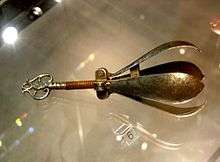Pear of anguish
The pear of anguish, or choke pear, is the modern name for a type of instrument displayed in some museums, consisting of a metal body (usually pear-shaped) divided into spoon-like segments that could be operated by turning a screw. The museum descriptions and some recent sources assert that the devices were used either as a gag, to prevent people from speaking, or internally as an instrument of torture, although these accounts have been disputed as implausible.[1]
Origins

There is no contemporary first-hand account of these devices or their use. However, through the design of the devices, such as metal consistency and style, these are often dated to the early modern period (circa 1600). An early mention is in F. de Calvi's L'Inventaire général de l'histoire des larrons ("General inventory of the history of thieves"), written in 1639, which attributes the invention to a robber named Capitaine Gaucherou de Palioly in the days of Henry of Navarre. Palioly would have used a mechanical gag to subdue a wealthy Parisian while he and his accomplices robbed the victim's home.[2][3]
Further mentions of the device appear in the 19th century. They are also mentioned in Grose's Dictionary of the Vulgar Tongue (1811) as "Choke Pears", and described as aids used in extortion, "formerly used in Holland."[4]
They were also discussed in a book by Eldridge and Watts, superintendent of police and chief inspector of the detective bureau in Boston, Massachusetts (1897). While accepting that ordinary pear-shaped gags exist, they observed that contemporary robbers used no such device as Palioly's Pear and cast doubt upon its very existence in the first place, saying that "fortunately for us this 'diabolical invention' appears to be one of the lost arts, if, indeed, it ever existed outside of de Calvi's head. There is no doubt, however, of the fashioning of a pear-shaped gag which has been largely used in former days by robbers in Europe, and may still be employed to some extent. This is also known as the 'choke-pear', though it is far less marvellous and dangerous than the pear of Palioly."[5]
Another mention is found in Brewer's Dictionary of Phrase and Fable (1898), which claims that "robbers in Holland at one time made use of a piece of iron in the shape of a pear, which they forced into the mouth of their victim. On turning a key, a number of springs thrust forth points of iron in all directions, so that the instrument of torture could never be taken out except by means of the key."[6]
As derived from its name, the mechanism of this contraption was originally meant to be inserted to one's mouth to crank the key piece to expand the metallic petals. The quadruple or triple petals expand outward, forcing the victim's inner mouth capacity to stretch beyond its limits.
Chris Bishop of Australian National University argues the construction of the oldest indicates it sprang open and the workmanship exceeds that expected from a torture device. Furthermore, the provenance of many of the devices is unknown and the workmanship indicates they are likely of recent manufacture, and the accounts of its use are not contemporary with the Middle Ages, making the accounts suspect.[7]
Museum pieces
Though there is little or no evidence of its being used by bandits, there are a number of extant examples of ornate and elaborate, pear-shaped devices with three or four leaves or lobes, driven by turning a key that rotates the central screw thread, which spreads the leaves. These are generally held in museums devoted to the subject of torture, and are described as instruments of torture by distension or evisceration. Some, but not all, have small spikes of uncertain purpose at the bottom of each leaf. However, these devices do not seem to match the descriptions given by Calvi or the 19th century sources.
See also
- Choke pear (plant), a hard-to-swallow fruit that may have been the origin of the instrument's name.
References
- Kirsch, Jonathan (2009). The grand inquisitor's manual : a history of terror in the name of god (1st HarperCollins pbk. ed.). New York, NY: HarperOne. pp. 2, 109. ISBN 978-0061732768.
- "La redoutable poire d'angoisse/Une expédition du voleur Palioli". La France pittoresque (in French) (21). Winter 2006–2007.
- marquis de Adolphe Chesnel (1856). Dictionnaire des superstitions, erreurs, préjugés et traditions populaires (in French). Paris: Migne. pp. 915–916.
- Francis Grose (1811). Dictionary of the Vulgar Tongue; a.k.a. Lexicon Balatronicum, A Dictionary of Buckish Slang, University Wit and Pickpocket Eloquence. Pall-Mall, London.
- Benjamin P. Eldridge and William B. Watts (2004) [1897]. Our Rival, the Rascal: A Faithful Portrayal of the Conflict Between the Criminals of This Age and The Police. Kessinger Publishing. pp. 285–286. ISBN 1-4179-5952-5.
- "Choke-pear". Brewer's Dictionary of Phrase and Fable. Bartleby.com. 1898.
- Bishop, Chris. "The Pear of Anguish: Torture, Truth and Dark Medievalism". , International Journal of Cultural Studies, vol. 17, no. 6. pp. 591-602. Retrieved 23 March 2016.
External links

- The Pear of Anguish (Torture)